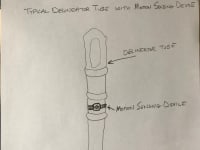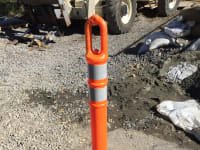Motion Sensing Delineator
Traffic Delineator Tubes are used in the construction industry to act as a visual barrier between workers and a safety hazard. They are typically a construction orange color, stand 4 feet tall, 6 inches in diameter, and are made of a heavy plastic.
The two main problems with conventional delineators are:
1. Over time, workers grow complacent. The delineator starts to "blend in" with the surroundings and its purpose is lost.
2. Delineators are hard to see for moving equipment such as fork lifts and "skid steers". Frequently, the operator requires a person or persons to "spot" the safety hazards when working in the vicinity of other moving equipment, existing structures, or open excavations. Therefore, the purpose is lost because the “spotter” is doing the job instead.
We need a delineator that actually warns people in the area of impending danger by sounding an alarm and flashing a beacon whenever they approach the safety hazard where the delineator has been placed. A Motion Sensing Delineator, or MSD, is just such a device.
The solution is simple and can be solved with existing technology; and it can be retrofitted to any brand of delineator product currently in use.
1. A proximity monitor, like the backup monitors used in the automotive industry, is to be encased in a small, weather-resistant housing, made of hard plastic – about the size of an ordinary wrist watch.
2. A tiny water-proof speaker and xenon flasher are also added into the housing.
3. This device is then threaded onto a 2" wide cotton blend, or nylon, web-type belt, with a double-loop buckle – much like a typical cinch belt.
4. The web-belt is strapped to the mid-section of the delineator.
5. The device is rugged, self-contained, battery operated, and intrinsically safe.
6. Several of these devices can be added to one belt for multi-directional usage.
The motion sensing device has two modes of operation:
1. Traffic Mode: Triggers Audible and Visual Alarms when motion is detected within 24” inches of sensor. Alarms go solid when the MSD is struck
2. Sentry Mode: Set the MSD to either flash and/or blip at constant intervals while workers are in the area. Several units can be synchronized to create a safety perimeter around a known hazard.
Like this entry?
-
About the Entrant
- Name:James Gilmore
- Type of entry:individual
- Patent status:none








